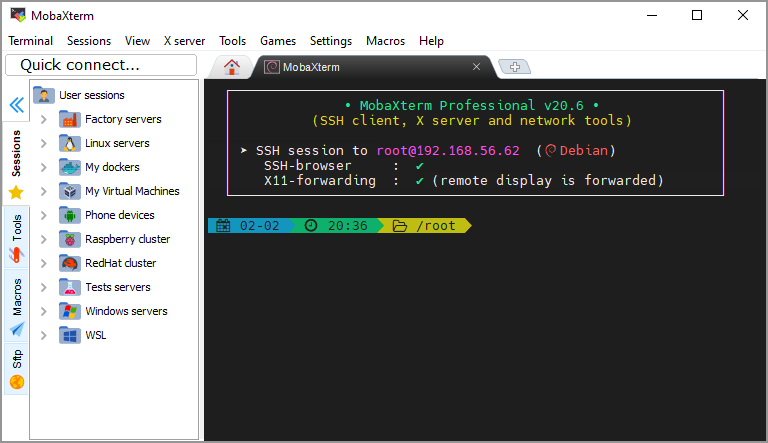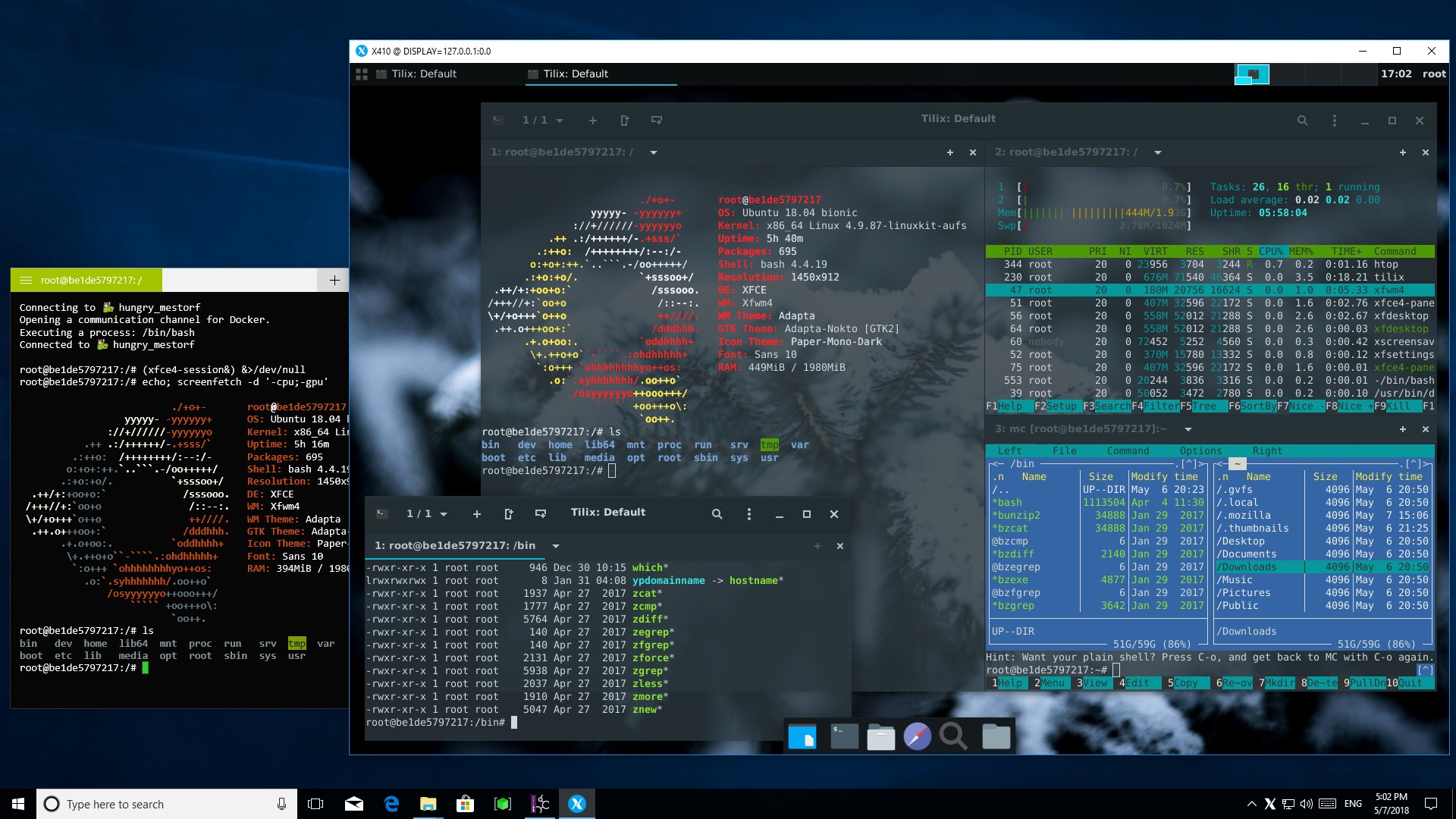I have an Ubuntu server (12.04 LTS) running remotely on a cloud hosting service. I have installed ubuntu-desktop via apt-get:
Jun 18, 2019 For a long time Windows 10 hasn't had a great command-line interface. As a result, developers and system admins have installed third-party options to emulate Unix style and other kinds of consoles. These are some of the best terminal emulators for Windows 10.
It appears to have installed no problem.
I have confirmed that /etc/ssh/ssh_config on the server contains the lines
and that /etc/ssh/sshd_config on the server contains the line:
I then rebooted the server. It came back up no problem.
Now, starting X11.app on my Mac I am presented with an Xterm.
I connect to my server from this terminal using:
and I connect to the server, no problem.
At this point I don't know what to do. I have tried
but I get a 'no screens found' error.
I don't have screens because its a headless cloud server, but I just want to acces it from my Mac through X.
What now?
Eliah Kagan3 Answers
There are several methods to accomplished that, depending of what you really need to do.
In order to forward remote apps to local X environment, you need to install X11 on your Mac (you can find it at apple support site): http://support.apple.com/kb/DL1605?viewlocale=en_US&locale=en_US
From the X11 app, open the terminal, and then access the remote host with:
Then, when logged, simply run the command for the desired app, ex: firefox, nautilus, thunderbird, whatever...
You can even launch only the system (Ubuntu, Xubuntu, Mint, etc..) Main Menu, and interact with the remote system from there, without the need of a full graphical front-end. On a remote Linux Mint env, i simply run:
If you really need it, you can even start the remote graphical environment locally at your Mac's X11, simply running:
Better than any VNC, even better than an X11VNC connection! Secured and compressed connection FTW.
On your Mac, you'll need to install XQuartz, if you haven't done so already (see http://xquartz.macosforge.org). Once that's installed, reboot and open an XQuartz terminal window and SSH to your Ubuntu Server system:
If lightdm is running (see https://askubuntu.com/a/153423/66799 to read how turn it on and off as needed), run this command to get Ubuntu Unity tunnelled to your Mac over X11:
This works for me with Ubuntu Server 12.04 LTS and Mac OS X Mountain Lion 10.8.2, but I do get occasional Composiz errors. That said, I always got Composiz errors when running Ubuntu Desktop locally, too. (-:

You can log out of Unity to close the Ubuntu Desktop windows.
You have the right idea but the wrong syntax :)
startx will not start over an ssh like that because it needs a screen (aka X server to talk to)
try this command to start the desktop gui
this will start the desktop environment.
disconnect.
and try
Xming X Server For Windows License
note did not test above line
Xming X Server For Windows Download

If everything works fine you should see the ubuntu file manager popup. If not you may be missing some librarys or the syntax of the command is wrong (of the top of my head didn't try it).
Luis AlvaradoNot the answer you're looking for? Browse other questions tagged macxserver or ask your own question.
For a long time Windows 10 hasn’t had a great command line interface. As a result, developers and system admins have installed third-party options to emulate Unix style and other kinds of consoles. And while it’s possible to get a bash shell inside Windows 10 now, many users still prefer a more configurable terminal emulator. Check out the best terminal emulators for Windows 10 below.
1. MobaXterm
Rammed with robust features like X11 servers, a library of plugins, and even its own protocol clients, MobaXterm is a great server tool with myriad Terminal options for those who really want to dig deep (conversely, you may find it a bit bloated if you just want to do lighter Putty work, for example).
It lets you set up remote terminals in SSH, telnet, rlogin and Mosh, and has an intuitive interface that lets you set up multiple SSH taps, split terminals horizontally/vertically, among other quality-of-life features. Naturally, it has all the Unix commands you need too, letting you work much as you would in Linux.
There’s a limited free version of MobaXterm that lets you have up to 12 sessions, two SSH tunnels, and 4 macros (it also has a portable version). If you want the full package, you’ll need to pay $69 for a lifetime right-to-use which removes all the aforementioned limitations.
2. ZOC Terminal
One of the best tools for people needing to access data on Unix accounts from Windows, ZOC Terminal, may not be free ($79.99), but it’s still a great value for more advanced users.
One of its key perks are tabs, so you can have several Terminal sessions going on at once across SSH, telnet, QNX, and other terminals. It’s brimming with commands and is highly customizable to suit your personal terminal-tinkering style.
Its emulations are robust and complete, offering features like mouse and keyboard support, print-through and line graphics. And it’s a cinch to search for specific bits of text in your work, then highlight them.
3. cmder
cmder is a well-known portable terminal emulator for Windows 10 that was built from the “pure frustration” caused by the lack of a good alternative in Windows. It’s built on top of another well-known console emulator, ConEmu, and enhanced with Clink. Clink extends the power of ConEmu, adding shell features like bash-style completion. It’s broadly compatible, working with msysgit, PowerShell, cygwin and mintty, bringing Unix capabilities to Windows.
Since it’s completely portable, you can run cmder off a USB drive that you use on various machines without installing files on local hard drives, making it a support specialist’s best friend. As a bonus, it ships with the much-loved Monokai color scheme to coordinate your hacking with Sublime Text.
4. ConEmu
ConEmu is a Windows console emulator with tabs, multiple windows and a variety of customization options. Its lineage reaches way back in history: ConEmu was initially created as a companion to Far Manager, a file and archive manager released for Windows in 1996. But despite its age, the software is continuously developed.
The emulator provides a deep menu of settings to tweak and hotkeys to assign, drawing in keyboard warriors from Vim and Emacs. ConEmu in compatible with many of the same popular shells as cmder, like cmd.exe, PowerShell, cygwin, PuTTY and others. If you install a DOS emulator like DosBox, you can run DOS applications in a 64-bit environment. But because ConEmu isn’t a shell, it doesn’t include helpful shell features like remote connections and tab completion. While it retains many die-hard fans, ConEmu might not be the best console emulator for new users.
5. Console
Console is a terminal emulator and console enhancement for Windows 10 that focuses on direct use and simple interaction. It provides full command-line capabilities, and its straight-forward design hides a significant degree of power and customization. It integrates with all the major shells and lets you customize window styles, transparency, fonts and text colors. But Console isn’t as all-spanning as ConEmu, so very advanced users might find themselves limited by the software.
6. Babun
Babun comes with bash and zsh out of the box, providing tools that both beginner and advanced users can use immediately. It’s built on top of Cygwin, porting a Unix-style interface to Windows 10. You can use oh-my-zsh to configure zsh’s wide variety of options, giving you greater control over your shell’s functionality that you’ll get in other applications. It also includes the pact package manager and HTTP proxying out the box.
7. Mintty
If you only use Cygwin for your Windows shell, then Mintty is an excellent console emulator. In fact, Mintty is installed as the default terminal emulator. Like the other options on this list, Mintty provides a collection of additional features like drag-and-drop, full screen, copy and paste and theme support. And it also works with MSYS and Msys2.
Conclusion
Cmder is probably the best bet for users looking for a capable but manageable terminal emulator. Users seeking a more powerful experience can get their fix with ConEmu or splash out a bit more for ZOC Terminal.
This article was first published in August 2017 and was updated in June 2019.
The Complete Windows 10 Customization Guide
In this ebook we’ll be exploring the multitude of options to fully customize Windows 10. By the end of this ebook you’ll know how to make Windows 10 your own and become an expert Windows 10 user.